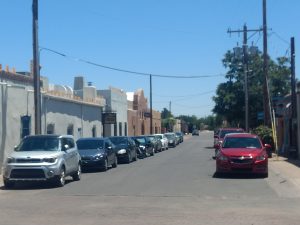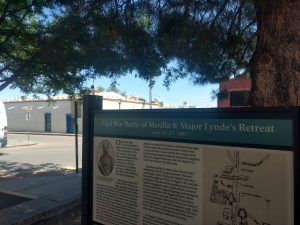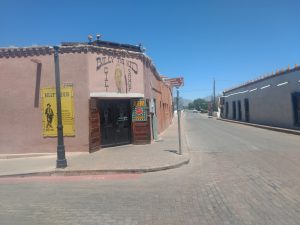ECW Weekender: Battles of Mesilla
 Sometimes juxtapositions grab our attention and draw us to see connections. On a recent trip to New Mexico to visit family, my thoughts turned to the Confederate invasion of what was then the Arizona Territory. Living close to the Confederate White House and Virginia State Capitol, it occurred to me how the decisions, plans, and policies enacted there reached the far flung and remote areas of the fledging nation, like Mesilla, New Mexico. In one day I left the heart of the Confederate government and visited perhaps its farthest outpost in Mesilla. In one location, amid the opulent Executive Mansion, decisions were made, and on the hot, dusty frontier, reality was on the ground.
Sometimes juxtapositions grab our attention and draw us to see connections. On a recent trip to New Mexico to visit family, my thoughts turned to the Confederate invasion of what was then the Arizona Territory. Living close to the Confederate White House and Virginia State Capitol, it occurred to me how the decisions, plans, and policies enacted there reached the far flung and remote areas of the fledging nation, like Mesilla, New Mexico. In one day I left the heart of the Confederate government and visited perhaps its farthest outpost in Mesilla. In one location, amid the opulent Executive Mansion, decisions were made, and on the hot, dusty frontier, reality was on the ground.

At the time of the war, about 800 people lived in the village of Mesilla. The town stood not far from the Rio Grande, along a major north-south trade route that had been used for centuries.
After the Mexican War (1846-48), the territory remained part of Mexico, but was purchased by the U.S. in the 1854 Gadsden Purchase. This acquisition was made to allow for construction of a southern transcontinental railroad.
On November 16, 1854 the United States flag rose above the plaza in the center of town, solidifying the Gadsden Purchase. Located in the center of the village, the plaza was flanked by several important community buildings, including a church and an adobe courthouse.
Today, the town is an inviting place, with local shops, galleries, restaurants, and bars. An imposing church stands at the north end of the plaza, and the old courthouse remains on the east side.
Fort Fillmore was established nearby in 1851 by Colonel Edwin V. Sumner, primarily for to protect settlers and traders traveling to California. In the prewar years Captain George Pickett and Ambrose Burnside served here.

During the Civil War, Mesilla saw the beginning and end of Confederate rule in the Southwest. At the time, the northern part of modern New Mexico and Arizona was known as the New Mexico Territory, while south of the 34th parallel was known as the Arizona Territory. Thus, instead of two states side by side, at the time the territories were one above the other.
On July 24, 1861, as the first step in conquering what was then known as Arizona Territory, Lt. Col. John R. Baylor led 300 men from Fort Bliss up the east bank of the Rio Grande to Fort Fillmore. His force included two companies of the 2nd Regiment of the Texas Mounted Rifles, a Texas light-artillery company, an El Paso County scout company, and some civilians.
One of his men deserted to Fort Fillmore’s defenders and forced Baylor to cancel his planned attack. Instead, he forded the Rio Grande and entered Mesilla, which was strongly pro-Confederate.
On July 25, with 380 infantry and mounted riflemen, plus howitzers, Maj. Isaac Lynde approached Mesilla from the south. Baylor rejected his demand for surrender, and Lynde ordered his artillery to open fire. After an unsuccessful charge, Lynde retreated to the fort. The Confederates about nine, while Lynde lost around twenty. The site of the battle is now part of the modern town.
Lynde abandoned Fort Fillmore that night and headed northeast toward San Augustin Pass in the Organ Mountains. On July 27, at sunrise, Baylor discovered Lynde’s withdrawal and pursued, overtaking and capturing them at San Augustin Springs. Baylor proclaimed Arizona Territory, Confederate States of America, in Mesilla on August 1 and named himself governor.

The following spring General Henry Sibley led a Confederate force further north to invade and conquer New Mexico Territory. Following defeats to the north at Glorietta Pass in March, 1862, the Confederates were driven south, back the way they had come from Texas.
On July 1, 1862 local pro-Union guerrilla forces, defeated the Confederates in a small skirmish near town. Three days later the including the California Column approached, and the southerners retreated back to Texas via El Paso, never to return.
Today, there is a historic marker in the town plaza noting the first battle which raged through the modern streets in 1861. Nearby plaques discuss the American acquisition of the territory in 1854. The Old Courthouse, with its original 18- inch thick mud brick walls, still stands, now a souvenir store. The building was a jail and courthouse until 1882, and it was there that Billy the Kid was tried and sentenced in 1881.
Fort Fillmore is gone, now covered by one of the massive pecan plantations that flourish in the valley. (Yes, Pecans have become a major staple of the economy, grown primarily for export to China). A historic marker along Route 70 to the west notes the site of San Augustin Springs, where the Union garrison was captured.
Within a twenty four hour period, thanks to the miracle of flight, I went from the heart of the Confederacy’s government to its fringe, and discovered one of the first battles of the war in an unlikely place.
Burt–those of us who live in the real West are pleased to see that the Civil War community is finally recognizing that this was a truly national conflict. Thanks for your article.
Thanks Meg! No one will ever accuse me of being Virginia-centric on this war.
What an interesting subject! Our Tennessee Valley Civil War Round Table break-out discussion group, “The Little Round Table” (for those who really want to get their history geek on) will be discussing the New Mexico Campaign of 1861-62 later this year, and I am recommending this article to our facilitator. Thank you.
Thanks David! There have been several good books on the campaign. Its a fascinating topic.